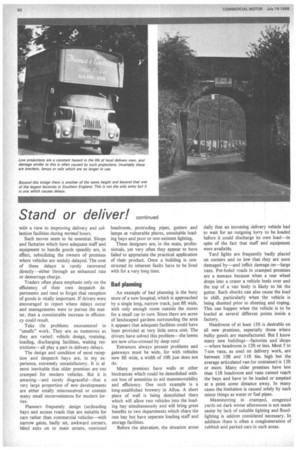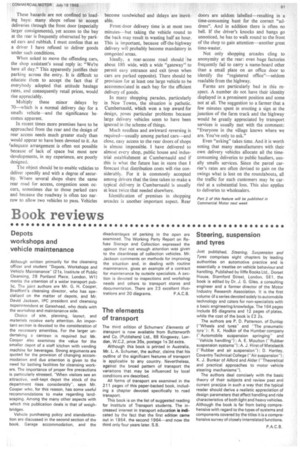Stand or deliver! continued with a view to improving delivery and collection facilities during normal hours.
Page 62

Page 63

If you've noticed an error in this article please click here to report it so we can fix it.
Such moves seem to be essential. Shops and factories which have adequate staff and equipment to handle goods speedily are, in effect, subsidizing the owners of premises where vehicles are unduly delayed. The cost of these delays is rarely recovered directly—either through an enhanced rate or demurrage charge.
Traders often place emphasis only on the efficiency of their own despatch departments and tend to forget that reception of goods is vitally important. If drivers were encouraged to report where delays occur and managements were to pursue the matter, then a considerable increase in efficiency could result.
Take the problems encountered in "smalls" work. They are as numerous as they are varied: vehicle design, routeing, loading, discharging facilities, waiting restrictions—all play a part in delivery delays.
The design and condition of most reception and despatch bays are, in my experience, extremely unsatisfactory. It is almost inevitable that older premises are too cramped for modern vehicles. But it is amazing—and surely disgraceful—that a very large proportion of new developments are either totally misconceived or contain many small inconveniences for modern lorries.
Planners frequently design (un)loading bays and access roads that are suitable for cars rather than commercial vehicles—with narrow gates, badly set, awkward corners, blind exits on to main streets, restricted headroom, protruding pipes, gutters and lamps at vulnerable places, unsuitable loading bays and poor or non-existent lighting.
These designers are, in the main, professionals, yet very often they appear to have failed to appreciate the practical application of their product. Once a building is constructed its inherent faults have to be lived with for a very long time.
Bad planning
An example of bad planning is the busy store of a new hospital, which is approached by a single long, narrow track, just 8ft wide, with only enough room outside the stores for a small car to turn. Since there are acres of landscaped gardens surrounding the area it appears that adequate facilities could have been provided at very little extra cost. The drivers have solved this problem—the lawns are now criss-crossed by deep ruts!
Entrances always present problems and gateways must be wide, for with vehicles now 8ft wide, a width of 10ft just does not do.
Many premises have walls or other hindrances which could be demolished without loss of amenities to aid manoeuvrability and efficiency. One such example is a long-established brewery in Alloa. A short piece of wall is being demolished there which will allow two vehicles into the loading bay simultaneously and will bring great benefits to two departments which share the one bay but have separate loading staff and storage facilities.
Before the alteration, the situation arose daily that an incoming delivery vehicle had to wait for an outgoing lorry to be loaded before it could discharge its own load—in spite of the fact that staff and equipment were available.
Yard lights are frequently badly placed on corners and so low that they are soon damaged by—and inflict damage on—large vans. Pot-holed roads in cramped premises are a menace because when a rear wheel drops into a crater a vehicle heels over and the top of a van body is likely to hit the gutter. Such shocks can also cause the load to shift, particularly when the vehicle is being shunted prior to sheeting and roping. This can happen when the vehicle is to be loaded at several different points inside a factory.
Headroom of at least 15ft is desirable on all new premises, especially those .where bulky goods are manufactured. But I know many new buildings—factories and shops —where headroom is 12ft or less. Most 5 to 7-ton vans, as used on delivery work, are between 10ft and 11ft 6in. high but the average articulated van (or container) is 1311 or more. Many older premises have less than Ilft headroom and vans cannot reach the bays and have to be loaded or emptied at a point some distance away. In many cases the limitation is caused solely by such minor things as water or fuel pipes.
Manoeuvring in cramped, congested yards on dark winter afternoons is not made easier by lack of suitable lighting and floodlighting is seldom considered necessary. In addition there is often a conglomeration of rubbish and parked cars in such areas.
These hazards are not confined to loading bays: many shops refuse to accept deliveries through the front door (especially larger consignments), yet access to the bay at the rear is frequently obstructed by parked cars and rubbish. I must confess that as a driver I have refused to deliver goods under such conditions.
When asked to move the offending cars, the shop assistant's usual reply is: "We're here all day." This apparently justifies their parking across the entry. It is difficult to educate them to accept the fact that if everybody adopted that attitude haulage rates, and consequently retail prices, would rise appreciably.
Multiply these minor delays by 70—which is a normal delivery day for a smalls vehicle and the significance becomes apparent.
In recent times more premises have to be approached from the rear and the design of rear access needs much greater study than would appear to have been devoted to it. An 'adequate arrangement is often not possible because of lack of space but most new 'developments, in my experience, are poorly designed.
The object should be to enable vehicles to deliver speedily and with a degree of security. Where several shops share the same rear road for access, congestion soon occurs, sometimes due to those parked cars and because the roadway is often too narrow to allow two vehicles to pass. Vehicles become sandwiched and delays are inevitable.
Front-door delivery time is at most two minutes—but taking the vehicle round to the back may result in wasting half an hour. This is important, because off-the-highway delivery will probably become mandatory in congested areas.
Ideally, a rear-access road should be about 18ft wide, with a wide "gateway" to permit easy entrance and exit (even when cars are parked opposite). There should be provision for at least one large vehicle to be accommodated in each bay for the efficient delivery of goods.
In many shopping parades, particularly in New Towns, the situation is pathetic. Cumbernauld, which won a top award for design, poses particular problems because large delivery vehicles seem to have been ignored in the scheme of things.
Much needless and awkward reversing is required—usually among parked cars—and close, easy access to the rear doors of shops is almost impossible. I have delivered to almost every shop, public house and industrial establishment at Cumbernauld and if this is what the future has in store then I forecast that distribution costs will rise considerably. For it is commonly accepted among drivers that the time taken to make a typical delivery in Cumbernauld is usually at least twice that needed elsewhere.
Identification of premises in shopping arcades is another important aspect. Rear doors are seldom labelled—resulting in a time-consuming hunt for the correct "address". And in addition there is often no bell. If the driver's knocks and bangs go unnoticed, he has to walk round to the front of the shop to gain attention—another great time-waster.
Not only shopping arcades cling to anonymity at the rear: even huge factories frequently fail to carry a name-board other than a small plate on an office door to identify the "registered office"—seldom readable from the highway.
Farms are particularly bad in this respect. A number do not have their identity displayed in a prominent position and some not at all. The suggestion to a farmer that a few minutes spent in erecting a sign at the junction of the farm track and the highway would be greatly appreciated by transport services is usually met with the comment: "Everyone in the village knows where we are. You've only to ask."
Even "asking" takes time. And it is worth noting that many manufacturers with their own delivery vehicles allocate all the timeconsuming deliveries to public hauliers, usually smalls services. Since the parcel carrier's rates are often devised to gain on the swings what is lost on the roundabouts, all the traffic for such customers may be carried at a substantial loss. This also applies to deliveries to wholesalers.
Part 2 of this feature will be published in Commercial Motor next week




















































































































